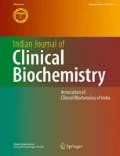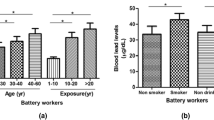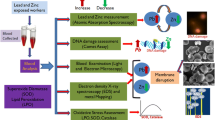Abstract
Lead poisoning remains a major problem in India due to the lack of awareness of its ill effects among the clinical community. Blood lead, δ-aminolevulinic acid dehydratase (δ-ALAD) and zinc protoporphyrin (ZPP) concentrations are widely used as biomarkers for lead toxicity The present study was designed to determine the impact of chronic lead exposure on selected biological markers. A total of 250 subjects, of both sexes, ranging in age from 20 to 70 years, were recruited. On the basis of BLLs, the subjects were categorized into four groups: Group A (BLL: 0–10 μg/dl), Group B (BLL: 10–20 μg/dl). Group C (BLL: 20–30 μg/dl) and Group D (BLL: 30–40 μg/dl) having BLLs of 3.60 ± 2.71 μg/dl, 15.21 ± 2.65 μg/dl, 26.82 ± 2.53 μg/dl and 36.38 ± 2.83 μg/dl, respectively. Significant changes in biological markers due to elevated BLLs were noted. The relation of BLL and biological markers to demographic characteristics such as sex, habits, diet and substances abuse (smoking effect) were also studied in the present investigation. Males, urban population, non-vegetarians, and smokers had higher blood lead levels. δ-ALAD activity was found to be significantly lower with increased BLL (P < 0.001), while the ZPP level was significantly higher with increased BLL (P < 0.001). Further, BLL showed a negative correlation with δ-ALAD (r = −0.425, P < 0.001, N = 250) and a positive correlations with ZPP (r = 0.669, P < 0.001, N = 250). Chronic lead exposure affects the prooxidant-antioxidant equilibrium leading to cellular oxidative stress.



Similar content being viewed by others
References
Sakai T. Reviews on biochemical markers of lead exposure with special emphasis on heme and nucleotide metabolism. Sangyo Eiseigaku Zasshi. 1995;40:314–7.
Somashekaraiah BV, Venkaiah B, Prasad AR. Biochemical diagnosis of occupational exposure to lead toxicity. Bull Environ Contam Toxicol. 1990;44:268–75.
Phillip AT, Gerson B. Lead poisoning-Part I. Incidence, etiology, and toxicokinetics. Clin Lab Med. 1994;14:423–44.
Gurer-Orhan H, Sabir HU, Ozgunes H. Correlation between clinical indicators of lead poisoning and oxidative stress parameters in controls and lead-exposed workers. Toxicology. 2004;195:147–54.
Fernandez FJ. Micromethod for lead determination in whole blood by atomic absorption, with use of the graphite furnace. Clin Chem. 1975;21:558–61.
Wigfield DC, Farrant JP. Assay of delta-aminolaevulinate dehydratase in 10 microlitre blood. Clin Chem. 1981;27(1):100–3.
Blumberg WE, Esinger J, Lamola AA, Zuckerman DM. The haematofluorometer. Clin Chem. 1977;23:270–1.
CDC (Centers for Disease Control and Prevention). Preventing lead poisoning in young children. Public Health Service, Centers for Disease Control, US Department of Health and Human Services, Atlanta, Georgia. 1991. http://www.cdc.gov/nch/lead/publicaion. Accessed 1 Jan 2008.
WHO (World Health Organization). International Programme on Chemical Safety (IPCS). Inorganic lead. Environmental health criteria 165. Geneva. 1995. http://www.inchem.org/documents/ehc/ehc/ehc165.htm. Accessed 21 Apr 2008.
Baghurst PA, McMichael AJ, Wigg NR, Vimpani GV, Robertson EF, Roberts RJ, Tong SL. Environmental exposure to lead and children’s intelligence at the age of seven years. New Engl J Med. 1992;327:1279–84.
Muntner P, Menke A, DeSalvo KB, Rabito FA, Batuman V. Continued decline in blood lead levels among adults in the United States: the National Health and Nutrition Examination Surveys. Arch Intern Med. 2005;165:2155–61.
Roels HA, Lauwerys RR, Buchet JP, Vrelust MT. Response of free erythrocyte porphyrin and urinary-delta-aminolevulinic acid in men and women moderately exposed to lead. Int Arch Arbeitsmed. 1975;34:97–108.
Grandjean P, Lintrup J. Erythrocyte–Zn–protoporphyrin as an indicator of lead exposure. Scand J Clin Lab Invest. 1978;38:669–75.
Mohammad IK, Mahdi AA, Raviraja A, Najmul I, Iqbal A, Thuppil V. Oxidative stress in painters exposed to low lead levels. Arh Hig Rada Toksikol. 2008;59:161–8.
Sprinkle RV. Leaded eye cosmetics: a cultural cause of elevated lead levels in children. J Fam Pract. 1995;40(4):358–62.
Sharma DC, Seervi N, Rawtani J. Effect of environmental lead pollution on hemoglobin and erythrocyte ALAD activity. Indian J Physiol Pharmacol. 2000;44(1):117–8.
Quinn MJ, Sherlock JC. The correspondence between U.K. ‘action levels’ for lead in blood and in water. Food Addit Contam. 1990;7:387–424.
WHO (World Health Organization). Lead in drinking water. Background document of WHO guidelines for drinking water quality, Geneva, WHO (WHO/SDE/WSH/03.04/09). 2003.
Ahamed M, Verma S, Kumar A, Siddiqui MK. Delta-aminolevulinic acid dehydratase inhibition and oxidative stress in relation to blood lead among urban adolescents. Hum Exp Toxicol. 2006;25(9):547–53.
Ahamed M, Singh S, Behari JR, Kumar A, Siddiqui MK. Interaction of lead with some essential trace metals in the blood of anemic children from Lucknow. India Clin Chim Acta. 2007;377(1–2):92–7.
Hulea SA, Olinescu R, Nita S, Crocnan D, Kummerow FA. Cigarette smoking causes biochemical changes in blood that are suggestive of oxidative stress: a case-control study. J Environ Pathol Toxicol Oncol. 1995;14(3–4):173–80.
Flora SJS, Singh S, Tandon SK. Plumbism among Indian silver jewellery industry workers. J Environ. Sci Health Part A 1990;25A (2):105–113.
Farant JP, Wigfeld DC. Biomonitoring lead exposure with delta-aminolevulinate dehydratase (ALA-D) activity ratios. Int Arch Occup Environ Health. 1982;51:15–24.
Sandhir R, Julka D, Gill KD. Lipoperoxidative damage on lead exposure in rat brain and its implications on membrane bound enzymes. Pharmacol Toxicol. 1994;74:66–71.
Ahamed M, Verma S, Kumar A, Siddiqui MK. Environmental exposure to lead and its correlation with biochemical indices in children. Sci Total Environ. 2005;346(1–3):48–55.
Austrin KH, Bishap DF, Wetmur JG, Kaul BC, Davidow B, Desnick RJ. Aminolevulinic acid dehydratase isozymes and lead toxicity. Ann NY Acad Sci. 1987;514:23–9.
Sakai T, Morita Y. Delta-aminolevulinic acid in plasma or whole blood as a sensitive indicator of lead effects, and its relation to the other heme-related parameters. Int Arch Occup Environ Health. 1996;68:126–32.
Bechara EJ. Oxidative stress in acute intermittent porphyria and lead poisoning may be triggered by 5-aminolevulinic acid. Braz J Med Biol Res. 1996;29:841–51.
Sakai T. Biomarkers of lead exposers. Ind Health. 2000;38:127–42.
Chiba M, Shinohara A, Matsushits K, Watanabe H, Inaba Y. Indices of lead exposure in blood, urine of lead exposed workers, concentrations of major, trace elements, activities of SOD, GsH-Px and catalase in their blood. Tohoku J Exp Med. 1996;178:49–62.
Goyer H, Clarkson TW. Toxic effects of metals. In: Klassen CD, editor. Casarett and Doull’s toxicology. The basic science of poisons. New York: McGraw-Hill; 2001. p. 830.
Jin Y, Liao Y, Lu C. Health effects in children aged 3–6 years induced by environmental lead exposure. Ecotoxicol Environ Saf. 2006;63(2):313–7.
Marcus AH, Schwartz J. Dose-response curves for erythrocyte porphyrin vs. blood lead, effects of iron status. Environ Res. 1987;44:221–7.
Onalaja VO, Claudio L. Genetic susceptibility to lead poisoning. Environ Health Perspect. 2000;108:23–8.
ATSDR (Agency for Toxic Substances and Disease Registry). Toxicological profile for lead. (Draft for Public Comment). Atlanta, GA: U.S. Department of Health and Human Services, Public Health Service. 2007;232. http://www.atsdr.cdc.gov/ToxProfile/tp.asp. Accessed 1 Jan 2008.
Author information
Authors and Affiliations
Corresponding author
Rights and permissions
About this article
Cite this article
Jangid, A.P., John, P.J., Yadav, D. et al. Impact of Chronic Lead Exposure on Selected Biological Markers. Ind J Clin Biochem 27, 83–89 (2012). https://doi.org/10.1007/s12291-011-0163-x
Received:
Accepted:
Published:
Issue Date:
DOI: https://doi.org/10.1007/s12291-011-0163-x




